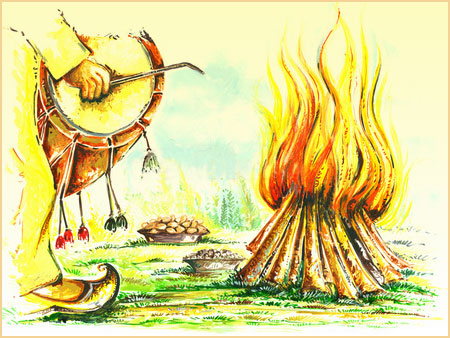With the chilly winter month of Paush coming to an end, it is time again to gear up for the yearly Lohri festivities. Check out our fascinating article on the history of Lohri and learn about the reason of observing the festival. If you like reading about the history of Lohri and feel your friends should know about it too, click here and refer them this page. Indulge in a fervid Lohri celebration!
Come the month of January and the whole of Punjab gears up to celebrate the Lohri festival. It is one of the most joyful occassions for every Punjabi, especially so for those families where there has been a recent marriage or the birth of a son.
Though there are different stories about the origin of Lohri, it has generally been accepted that the occassion has always been celebrated as a harvest festival. Coming at the end of the winter season, it marks the last day of the month Paush, and beginning of the month Magha (January 12/13 as per the Gregorian calendar). It is during this time that the farm fields gleam with wheat, the primary North Indian crop.
Lohri is essentially a festival dedicated to fire and the sun god. The celebration of Lohri marks the time when the sun shines from the "Uttrarayan", meaning it passes across Makar (the zodiac sign Capricorn) and moves northwards. This alteration of the sun's position lessens the severity of the winter season and the earth receives warmth bringing comfort to her inhabitants. Lohri celebrates this impending comfort and sees nightlong festivities that has people lighting bonfires to combat the chilly weather, and singing and dancing around it in a festive mood. The fire also symbolizes the sun and is seen as a source of energy and spiritual strength. It is worshipped as a deity with food-offerings consisting of peanuts, popcorn and sweets made of til-chirva, gajak and revri.

It can safely be said that the observation of Lohri has the dual purpose of celebrating the annual harvest and propitiating the sun-god both of which has tremendous importance in the life of a North Indian, especially those belonging to its agrarian society. Farmers form a major part of the celebrants of Lohri. The festival sees enthusiastic celebrations by both Sikhs and Hindus, in the North Indian states of Punjab, Haryana, Delhi and some areas of of Himachal Pradesh.
The festival is also celebrated in many other states of India, albeit under different names. In Bengal the occassion is observed as "Makar Sankranti" as "Magha Bihu" in Assam and as "Tai Pongal" in Kerala. A similar celebration of the annual harvest, Pongal, occurs in Tamil Nadu. Despie being observed under different names, the underlying purpose of its celebration remains expressing gratitude to the almighty for his blessings in the form of bounteous harvest and comfortable weather conditions.